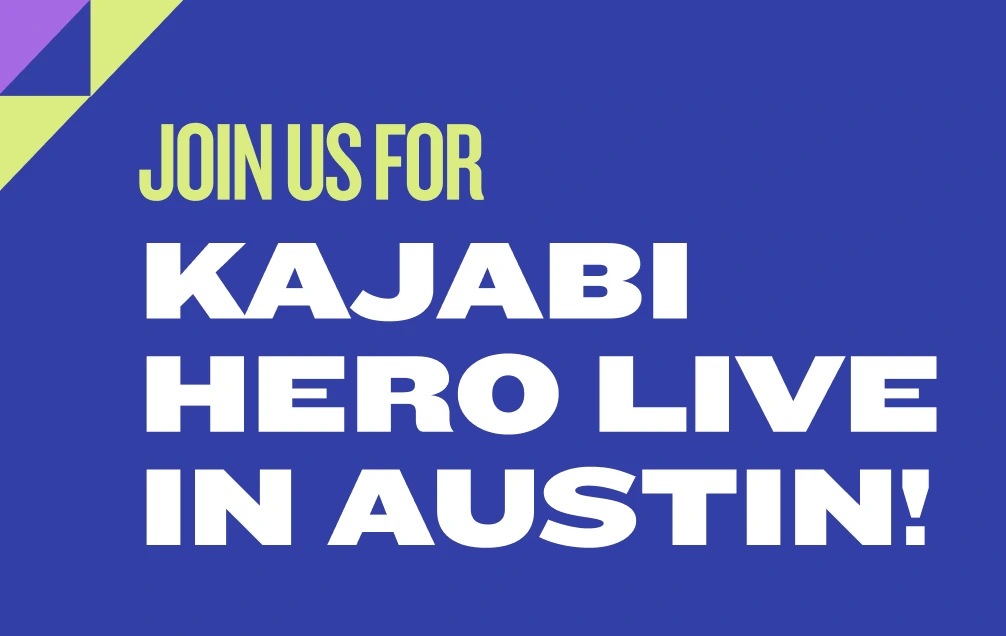
How to drive traffic to your website
Get free expert insights and tips to grow your knowledge business sent right to your inbox.
Web traffic isn’t, as many people claim, a simple vanity metric. It’s the law of numbers. Learning how to drive traffic to your website can boost your sales exponentially.
Why? Because more people will get exposed to your brand. They won’t all buy, of course, but a significant portion of them will if you present them with a compelling offer.
We’ve taught you how to build an awesome online course, how to market your business via email, and how to optimize your sales pages, but without traffic, none of those things matter.
Your goal is to turn your Kajabi website into a magnet that pulls people in from other sources, whether it’s social media or the search engines. This is particularly essential for Knowledge Commerce marketers because you have to establish credibility with your potential customers.
You can try every marketing strategy available to you, but you need traffic to produce conversions.
That’s what we’re going to help you with today. We’ve come up with 35 strategies that help drive traffic to your website. Best of all, you can do all of them with just a few minutes of preparation.
The Importance Of Website Traffic

You might have heard that the first thing a brick-and-mortar business owner needs to consider is location. A bad location can lead to a bankruptcy a few months down the line.
This is because a poor location results in light foot traffic. If customers can’t see your business, they don’t know to stop in and take a look. That’s bad for business.
A good location, however, is highly visible. People can see it from the street or sidewalk. The signage gets their attention. They walk through the door.
That’s exactly why you need to learn how to drive traffic to your website. You’re not after the sound of that little bell over the door, though. You’re after clicks.
Without clicks, you can’t hope to stay in business. You need people to read your blog, visit your landing pages, and check out your sales copy.
Otherwise, they won’t know about your amazing Knowledge Commerce products. They can’t sign up for your online course or join your membership site.
Many entrepreneurs call website traffic a vanity metric. And it is — but only if you’re relying on it after you’ve established regular traffic. At the beginning, or before you have reliable sales, website traffic is one of the most important metrics to track.
How To Drive Traffic To Your Website
Now that we’ve established why you should learn how to drive traffic to your website, how do you get people to click? What channels can you use to increase web traffic over the coming days, weeks, months, and years?
We’ve put together 35 strategies for you to try. Each tip will not only help you drive website traffic today, but it will also help you bring in consistent traffic.
Let’s be honest: You’d rather do less work with better results than more work with weak results, right? The best marketing strategies help drive passive traffic so you can focus on other things, like creating new online courses.
1. New Content Creation

Content that converts is one of your business’s most valuable assets. Great content can continue to drive clicks for your website long after you first publish it.
Blog articles are among the most popular types of content. They provide evidence of your knowledge, boost your credibility, and help bring in traffic from search engines.
However, consistency and quality matter far more than quantity. You can publish 10 blog posts per day and never get more than a few clicks a month.
That’s because the Internet has become saturated with low-quality content. Google often disregards these types of posts because they don’t help users solve problems, reach goals, or understand solutions.
You’re better off publishing one long, detailed, well-researched article per month than 10 300-word posts full of filler every week.
But what constitutes great content?
- It solves a legitimate problem that the searcher has.
- Visitors can immediately ascertain the article’s value and structure upon visiting the site.
- Images help guide the reader through the content.
- Headings, subheadings, and bulleted lists help break up the text.
- Statistics or data points help support the content’s assertions.
Additionally, great content features good grammar, spelling, and punctuation. If you publish poorly written copy, you risk damaging your credibility.
Set up a consistent publishing schedule for your blog and social media accounts. The more juicy content you serve up, the more your website traffic will grow.
2. Old Content Optimization
Maybe you have lots of old content on your blog or website. Don’t let it languish in obscurity.
You can revisit old content to update the data, add more relevant references, and give it more meat. Republish it with a new date so it goes to the top of your blog.
Simply lengthening old articles can have a big impact on your website traffic. The top-ranking articles on Google’s SERPs tend to be longer than 2,000 words.

There are exceptions, of course, but Google’s tendency to rank longer content higher is unmistakable.
However, you can’t just throw a bunch of words on the page and hope to rank. Instead, you have to add valuable content that will impress readers and convince them to stick around.
3. More Frequent Posts
It’s true that consistency and quality matter more than quantity, but posting more frequently sends an important signal to Google. It tells the search engine that you’re more active, which inspires the bots to crawl your site more often.
Your content will rank higher and faster if you keep up a steady posting schedule.
Maybe you only post once per week right now. Consider adding a second post — one on Monday and another on Friday, for example — to test the results. If your website traffic increases, you’ll know you’re on the right track.
4. Varied Content Length and Type
Another way to attract traffic is to vary the types of content you post and their length. While you don’t want to go off-topic and risk confusing your readers, you can throw in the occasional deviation from your usual routine to see what happens.
An ultra-long post, for instance, might drive more traffic than you expected. Alternatively, a roundup post could contrast with your mostly-original articles.
5. Improved Headlines
Never underestimate the power of a good headline. It’s what readers see when they search in the SERPs, run across your content on social media, or get an email with a roundup of your latest posts.
Try keeping your headlines at around 55 characters each. Focus on capturing reader curiosity so they have no choice but to click through and check out your content.
6. Content Promotion Via Outbrain or Taboola
Outbrain and Taboola help place native ads. These are the sponsored posts on sites like Forbes and Fortune — the ones that have clickbait headlines like “You Won’t Believe How Fast This Woman Lost 25 Pounds.”
Try promoting your content through Outbrain or Taboola. You’ll get more eyes on your content and discover how easy it is to drive traffic to your website.
7. New Products
Launching a new product can massively increase your traffic. By inspiring curiosity and interest among your target audience, you can get them to click over to your site and see what you have available.
Content centered around new product launches often drive the most traffic among existing customers. They liked what you sold before, so they want to see what new Knowledge Commerce product you’ve cooked up for them.
8. Online Course

Your online courses can also help drive traffic. Present your courses as solutions to common problems, then watch your incoming traffic soar.
Your goal is to help people, so make sure they understand the features and benefits of every online course you create. Before, during, and after the product launch, create content that promotes the course while still providing actionable value to readers.
9. Landing Pages

Think of landing pages as conversion machines. They not only attract traffic, but help turn interested consumers into customers.
Create one for each of your digital products. Optimize it for the links that point to it. For instance, if you’re using social media to drive traffic to a landing page, make sure the copy on the page lives up to the information on Facebook or Twitter.
10. YouTube Channels
Many people assume that videos aren’t helpful for traffic. They’re wrong. You can optimize a YouTube video description with targeted text, then include a CTA with a link back to your site. You can even put CTAs in your videos themselves, which makes clicking over a snap.
11. Comment Responses
It’s true that most blogs use nofollow links in their comments sections, which makes those links relatively useless for SEO purposes. However, the blog’s author and other commenters will see your link. If you provide good value, they might just click over.
12. Long-Tail Keyword Optimization
Speaking of SEO, don’t neglect long-tail keywords. They’re the best source of organic web traffic from the search engines.
For instance, instead of optimizing your content for “fitness online course,” optimize it for “beginner fitness online course” or “marathon training online course.” You’ll get more exposure in the SERPs and more clicks.
13. Guest Blogging
When you write a guest blog post, you typically get at least one link in your author bio. Some bloggers also allow you to put one or two links in the body of the post.
These do follow links can help you build your domain authority on your website, drive traffic from the blog’s audience, and boost your rankings in the SERPs. Guest blogging is ideal for anyone who wants to boost traffic and rankings in one fell swoop.
Look for blogs written by people who are not direct competitors of your business, but whose niches relate to yours. For instance, if you create fitness online courses, you could write a guest post for an exercise blogger who makes money through affiliate links.
14. Guest Post Offers
The other side of the coin can work just as well. Let other people guest post on your blog to give them exposure, boost your site’s authority, and drive up traffic. When that person’s post goes live on your blog, he or she will likely link to it from multiple places.
Just make sure you’re accepting guest posts from people who are passionate about your niche and who write well. You don’t want to spend hours cleaning up a poorly written post — or suffer the backlash if the person espouses incorrect facts or otherwise irritates your audience.
15. Referral Traffic
You can use Kajabi’s built-in analytics to track referral traffic to your website.
Tracking referral traffic allows you to replicate previous success. Maybe lots of bloggers link to one of your blog posts. Write a similar post in the future, then send links to those bloggers. They might provide more backlinks to this new post.
16. Partnerships
Partnering with another online entrepreneur can help you drive traffic to your website, too. Sharing audiences is a tried-and-true tactic that was used even before the Internet became the primary way to market products and services.
Consider partnering with another Knowledge Commerce professional, an e-commerce marketer, or a blogger. Cross-promote each other’s products, services, or posts to help each other drive more traffic.
17. LinkedIn
LinkedIn’s publishing platform can be great for driving traffic. You can cross-post your blog content or create original content for LinkedIn. It’s best for Knowledge Commerce professionals who teach other professionals.
You can also post a teaser for your blog posts on LinkedIn. Include a link at the end with anchor text like “click to read more.” It’s a great way to convince people to click through and continue reading the post on your site.
18. Medium
The LinkedIn strategy also works for Medium. Just create an account and start publishing. You can cross-post or create original content — whichever works best for your business.
19. Internal Links
Your bounce rate increases when people land on your website, then click away right off the bat. That’s not what you want to happen.
Internal links (links on a page that lead to other pages on your website) can boost SEO and drive more traffic. If someone visits more pages on your website, they’re more likely to buy.
20. Webinar Hosting
We’re big fans of webinars here at Kajabi. It’s an easy way to generate web traffic and sales without ever leaving the Kajabi platform. You can host live webinars and publish the recordings for future viewing.
Webinars should offer valuable tips, strategies, or advice. If you’re hosting one live, make sure to allow people to ask you questions during the event. Allowing people to register well in advance can increase viewership as well as traffic.
Free Training: 3 Simple Steps To Quickly Launching Your First Online Mini-Course
Register here to watch our free training today!
21. Aggregator Site Submissions
While site aggregators, from Stumbleupon to Blogorama, might not help your SEO much, they can drive traffic among active users of those sites. Site aggregators have listings for every blog or website that participates.
You get a link to your website or blog as well as, in some cases, a brief description of what your site offers. Some aggregators, such as Stumbleupon, have listings for individual posts.
22. Video Content Creation
Even if you don’t use YouTube, you shouldn’t miss out on the power of video. Great videos help people solve real problems in an entertaining and engaging way.
You can host your videos on Kajabi and share them on social media. Many people view videos more often than they read text-based content.
23. Social Media
Don’t forget about social media when you want to drive more traffic to your website. Social media offers a dynamic platform for your content, regardless of your niche or industry.
Some of the most popular social media sites include the following:
- Google Plus
- Snapchat
Choose between one and four social media platforms at first. Add new ones once you master the initial picks. You don’t want to spread yourself too thin, but neither do you want to give up potential traffic.
24. Advertising
Paid advertising, whether on social media or search, can vastly increase your web traffic. Keep in mind that you’ll have to keep up those short-term gains by hooking your visitors from the moment they land on your site.
Many paid ads work best when combined with a can’t-miss offer, such as a discount on your latest online course. Make sure you narrow your potential audience as far as possible so you don’t waste money on irrelevant clicks.
Additionally, consider testing via multiple advertising channels. You’ll never know if Facebook Ads will generate more clicks and conversions than Twitter Ads unless you try them both. The same goes with Google and Bing.
25. Schema Microdata Implementation
Adding Schema markup to your website’s HTML is another great method when you’re learning how to drive traffic to your website. Schema micro-data helps search engines more precisely identify the contents on a web page.
For instance, on your sales pages, you could use the “Offer” schema micro-data. This tells the search engines that you’re offering a product for sale. Google, Yahoo!, and other search engines can then return your sales page in the SERPs when they believe that someone is searching for an offer like yours.
You can get as detailed with your Schema micro-data as you want. The more markup you add, the more transparent your web page becomes for search engines.
26. Industry Leader Interviews
Interviews often drive significant traffic, especially if the subject is a well-known industry expert. You probably won’t be interviewing Ryan Gosling or Taylor Swift on your website, but you don’t need someone with celebrity status.
Think about people who often get mentioned in conjunction with industry jargon. Send them polite interview requests with potential interview questions included. Make sure to let them decide whether they would prefer an email, phone, or video interview.
27. Email Marketing
We’ve covered email marketing at length here on the Kajabi blog, and for good reason. It’s a great way to remind your audience that you exist and to prompt them to visit your website.
28. Converting to Responsive Design

Responsive design fits the screen no matter how big or small it is. It renders perfectly across all devices, from desktop computers to smartphones. Kajabi has lots of responsive themes from which to choose, so make sure you’re taking advantage of them.
29. Speeding Up Your Website
Did you know that website speed can have a huge impact on web traffic? Not only do many people click away from a site that takes too long to load, but search engines also rank those websites lower.
Speed up your website by reducing image sizes, caching the data, and using embeds only sparingly.
30. Community Building
Creating a community or forum where your audience can hang out is a great way to boost website traffic. However, if you don’t have the time or inclination to build a community forum, just pay more attention to website comments. Get actively involved in conversations there to show that you’re engaged and interested.
31. Industry Blog and Website Comments
Similarly, you can participate in other communities. Visit your favorite blogs and leave detailed, relevant comments. Reply to other commenters, as well, and let the author know when you appreciate his or her content.
This might seem like a waste of time, since you’re not joining a conversation on your own site. However, others will pay attention to what you say and might click through to see what your website is about.
32. Competitive Research
If you don’t know what your competitors are doing, how can you beat them at the website traffic game? Maybe you’ll discover that your closest competitor posts lots of videos. You’ll know that you should record videos, too, to stay relevant with your audience.
Your competitors likely create certain types of content because they work. You can skip doing your own research and jump right to the solution.
33. Conferences and Other Events
Getting out from behind the computer every once in a while can yield amazing results. Attending conferences and other events puts you directly in front of the people who matter most: current and potential customers.
Make sure you have business cards or other literature to hand out. These documents should have your website’s URL typed prominently on it. That way, attendees can later look up your site and check out your digital products.
34. Q&A Websites
Another great way to generate traffic is to participate in Q&A websites, such as Yahoo! Answers and Quora. These websites let participants ask questions to get answers from experts as well as answer others’ questions.
You’ll instantly build your credibility if you answer questions with care and an eye for detail. Give as much value as possible in every sentence to convince people that you’re someone worth following.
35. Changes Based on Web Analytics

While experimenting with new ideas is always fun, you also need to pay attention to the analytics you collect on Kajabi and from third-party programs. You’ll start to see trends and patterns that should dictate how you spend your time in the future.
If you notice that you’re getting lots of referral traffic from Quora, for example, you’ll know that you need to spend even more time answering questions and helping people on that site.
Additionally, you can investigate sudden spikes and dips in traffic. Maybe you got a low-quality backlink that has dropped your rankings, or perhaps you’ve published a viral blog article. Whatever the case, you’ll want to know the reason so you know how to move forward.
Use Kajabi To Turn Your Knowledge And Content Into Products You Can Sell

As we mentioned above, you can take advantage of most of these strategies with your Kajabi website. Use our back-end analytics and other tools to monitor and expedite your marketing campaigns.
Best of all, you can spread your knowledge faster and wider. The more traffic you get from people who are interested in your digital products, the more money you can make — and the more lives you can influence.
Conclusion
Website traffic isn’t just a vanity metric. It tells you whether or not people are visiting your site.
There are lots of ways to drive more traffic to your website. From creating new content and optimizing old content to creating landing pages and cross-posting on LinkedIn and Medium, you have plenty of opportunities to get your website more eyeballs.
Don’t dismiss tactics like partnering with other professionals, building internal links, and establishing a welcoming community on your website. Consider guest blogging, creating videos, and improving your headlines.
You also have to pay attention to your analytics. Consider implementing Schema micro-data to make your website more visible to search engines and conducting more email marketing to stay in touch with your subscribers.
Taking advantage of all the tips on this list will improve your website traffic as well as your conversion rates.
Get started with Kajabi
Join 60,000 other knowledge commerce online business owners who have earned more than $5 billion in revenue on Kajabi. Sell online courses, host a membership community, be a coach, and offer paid or free podcasts - all in one tool. Start your free trial today!
Find more blog posts by category:
Create Your Product
Build Your Business
Grow Your Business
Marketing













